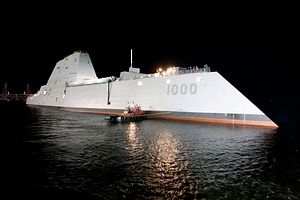The Government Accountability Office (GAO) in its annual survey of U.S. Department of Defense (DoD) acquisitions criticizes several aspects of the U.S. Navy’s DDG 1000 Zumwalt-class program, the services largest and technologically most advanced class of new guided-missile destroyers.
First, the GAO report finds that the Navy still does not have a suitable projectile for its two Advanced Gun Systems on the 16,000-ton destroyer, with the result that the surface combatants remain incapable of executing land-strike missions for now. The service initially planned to procure the Long-Range Land Attack Projectile (LRLAP) for the destroyer, but with a cost of $800,000 to $1 million per round, LRLAP was found to be too expensive. “Following an evaluation of five other munition options, the Navy determined that no viable replacement, guided or unguided, was feasible,” the report notes. “As a result, the guns will remain inoperable on the ships for the foreseeable future.”
Second, the Navy and General Dynamics-Bath Iron Works (BIW) shipyard were also found not to have stabilized the Zumwalt-class’ design before the construction of the first-of-class USS Zumwalt (DDG 1000) was kicked off in 2009, a major mistake according to the GAO report. “This approach contributed to numerous design changes after the fabrication start and significant cost increases and schedule delays,” the survey notes. “Nearly ten years later, development and shipboard testing of technologies continues, each of which could lead to discovery that could disrupt the design stability the Navy currently claims.”
Third, the report also calls into question the planned delivery date of the USS Zumwalt and its sister ship, USS Michael Monsoor (DDG 1001) to the Navy and how it may impact the ships’ overall capabilities. It notes that several deficiencies have been identified during an evaluation by the Board of Inspection and Survey, the U.S. Navy’s main organization inspecting and reporting on a warship’s readiness for active duty operations. “Specifically, the board found over 320 serious deficiencies when the shipbuilder delivered DDG 1000’s HM&E in May 2016, and 246 serious deficiencies after the Navy conducted acceptance trials for DDG 1001 in January and February 2018,” according to the GAO. “This increases the likelihood that the ship will not be fully capable and sustainable when provided to the fleet.”
Notably, the delivery of the first-of-class USS Zumwalt has now been rescheduled from May to September 2019.
Lastly, in November 2017, the Navy changed the mission requirements of the Zumwalt-class from a land-attack platform to surface warfare, which entails fitting the destroyers with Raytheon’s SM-6 long-range supersonic missile and the subsonic long-range Maritime Strike Tomahawk, in addition to other systems needed for the class’ new primary mission. However, “the Navy has yet to establish testing plans to evaluate these future mission sets,” the GAO finds. “According to Navy officials, the Navy’s planned modifications to support the new mission will cost about $1 billion, from non-acquisition accounts.”
Despite the various issues outlined in the report, overall progress of the DDG 1000 program has been steady if occasionally delayed. The USS Zumwalt embarked on its first “operational period at sea,” in March of this year. The USS Michael Monsoor was commissioned in January 2019, while the future USS Lyndon B. Johnson (DDG 1002), the third and final ship of the Zumwalt class was launched in December 2018.

































